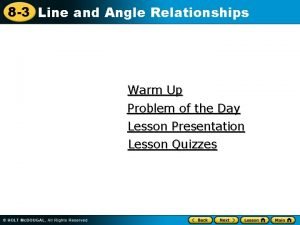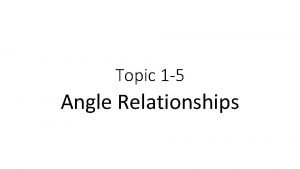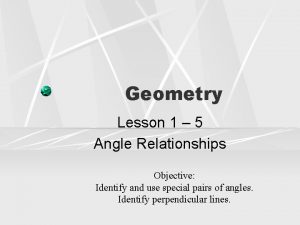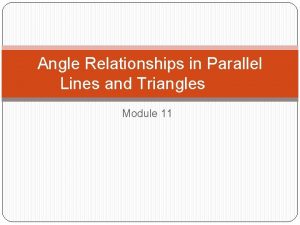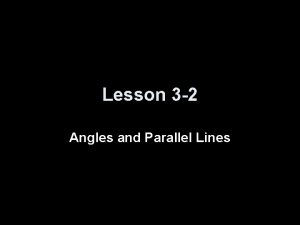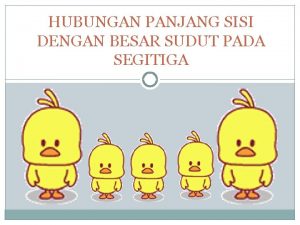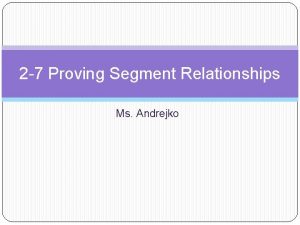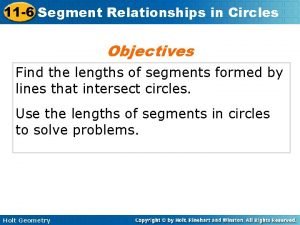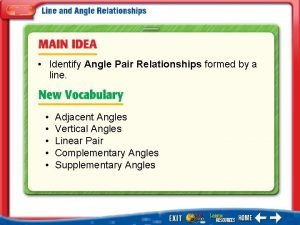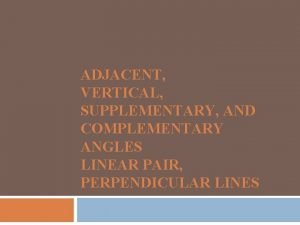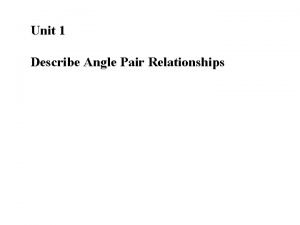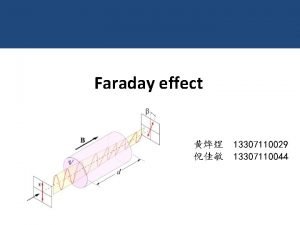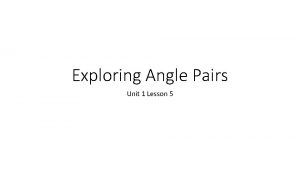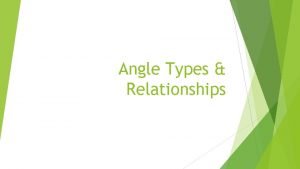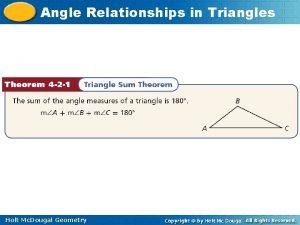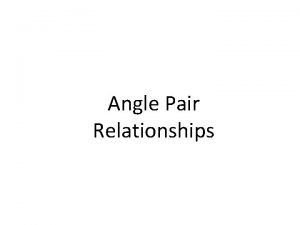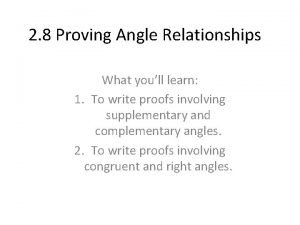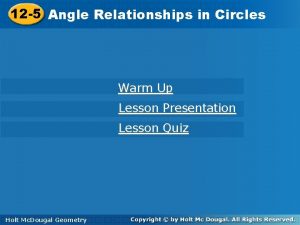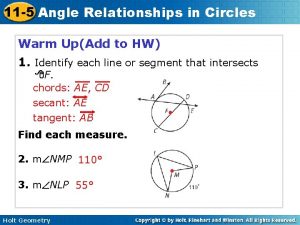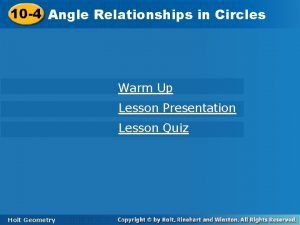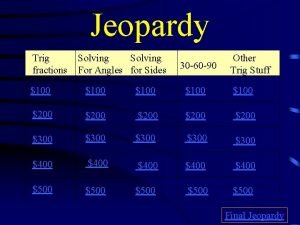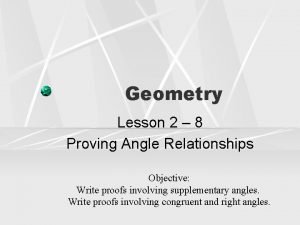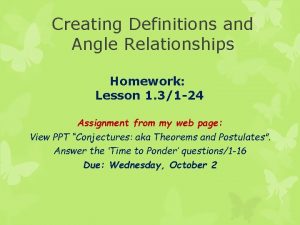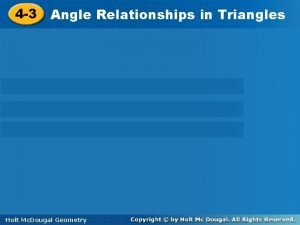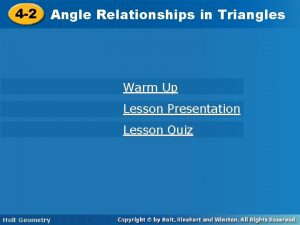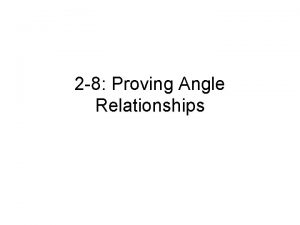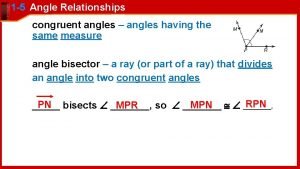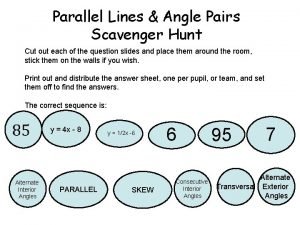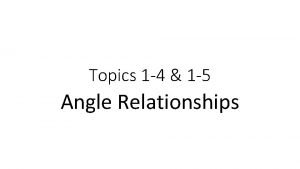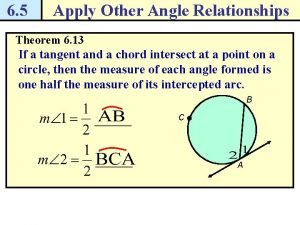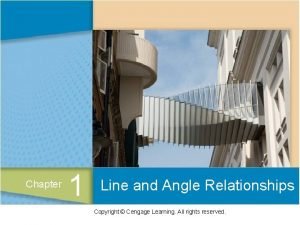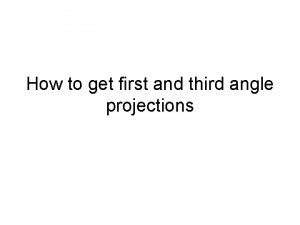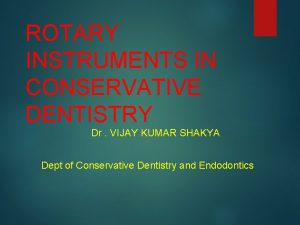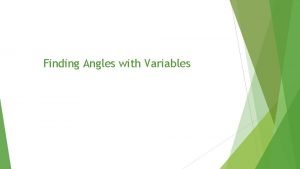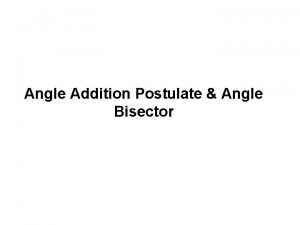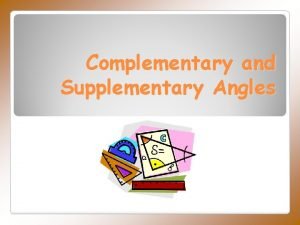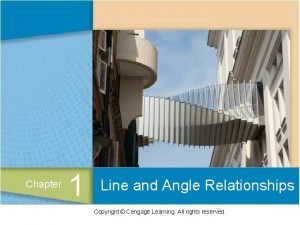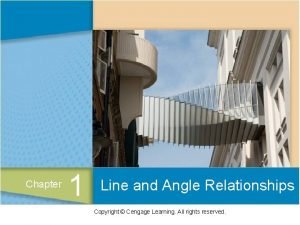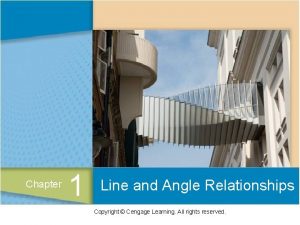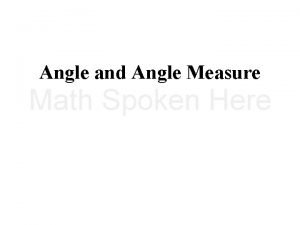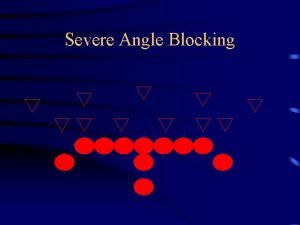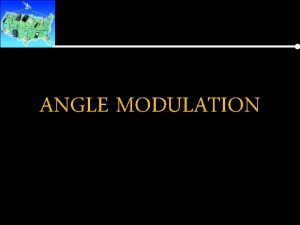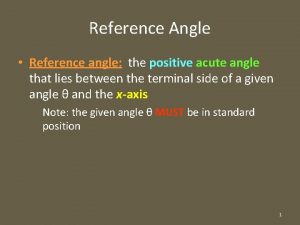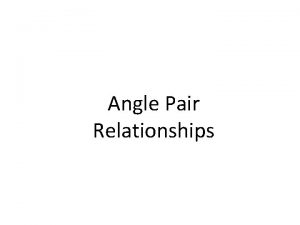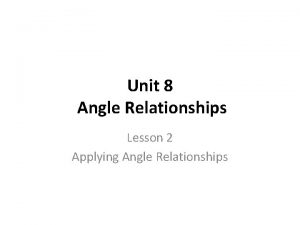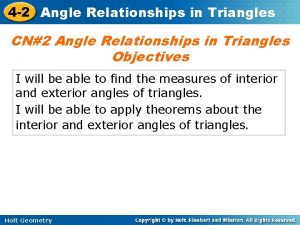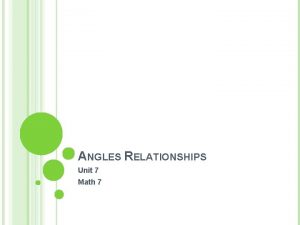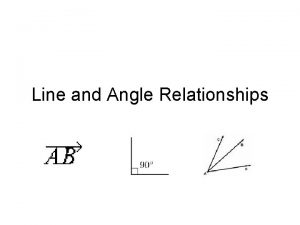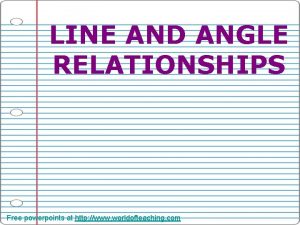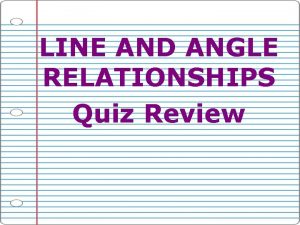Line and Angle Relationships Chapter 1 Line and








































- Slides: 40

Line and Angle Relationships Chapter 1 Line and Angle Relationships Copyright © Cengage Learning. All rights reserved.

1. 3 Early Definitions and Postulates Copyright © Cengage Learning. All rights reserved.

A MATHEMATICAL SYSTEM 3

A Mathematical System Like algebra, the branch of mathematics called geometry is a mathematical system. The formal study of a mathematical system begins with undefined terms. Building on this foundation, we can then define additional terms. Once the terminology is sufficiently developed, certain properties (characteristics) of the system become apparent. These properties are known as axioms or postulates of the system; more generally, such statements are called assumptions. 4

A Mathematical System Once we have developed a vocabulary and accepted certain postulates, many principles follow logically as we apply deductive methods. These statements can be proved and are called theorems. The following box summarizes the components of a mathematical system (sometimes called a logical system or deductive system). 5

CHARACTERISTICS OF A GOOD DEFINITION 6

Characteristics of a Good Definition Terms such as point, line, and plane are classified as undefined because they do not fit into any set or category that has been previously determined. Terms that are defined, however, should be described precisely. But what is a good definition? A good definition is like a mathematical equation written using words. A good definition must possess four characteristics. 7

Characteristics of a Good Definition An isosceles triangle is a triangle that has two congruent sides. In the definition, notice that: (1) The term being defined—isosceles triangle—is named. (2) The term being defined is placed into a larger category (a type of triangle). (3) The distinguishing quality (that two sides of the triangle are congruent) is included. 8

Characteristics of a Good Definition (4) The reversibility of the definition is illustrated by these statements: “If a triangle is isosceles, then it has two congruent sides. ” “If a triangle has two congruent sides, then it is an isosceles triangle. ” 9

Characteristics of a Good Definition The reversibility of a definition is achieved by using the phrase “if and only if. ” For instance, we could define congruent angles by saying “Two angles are congruent if and only if these angles have equal measures. ” The “if and only if” statement has the following dual meaning: “If two angles are congruent, then they have equal measures. ” “If two angles have equal measures, then they are congruent. ” 10

Characteristics of a Good Definition When represented by a Venn Diagram, the definition above would relate set C = {congruent angles} to set E = {angles with equal measures} as shown in Figure 1. 30 The sets C and E are identical and are known as equivalent sets. Definition A line segment is the part of a line that consists of two points, known as endpoints, and all points between them. 11

Example 1 State the four characteristics of a good definition of the term “line segment. ” 1. The term being defined, line segment, is clearly present in the definition. 2. A line segment is defined as part of a line (a category). 3. The definition distinguishes the line segment as a specific part of a line. 12

Example 1 cont’d 4. The definition is reversible. i) A line segment is the part of a line between and including two points. ii) The part of a line between and including two points is a line segment. 13

INITIAL POSTULATES 14

Initial Postulates Recall that a postulate is a statement that is assumed to be true. Postulate 1 Through two distinct points, there is exactly one line. Postulate 1 is sometimes stated in the form “Two points determine a line. ” See Figure 1. 32, in which points C and D determine exactly one line, namely, Figure 1. 32 15

Initial Postulates Of course, Postulate 1 also implies that there is a unique line segment determined by two distinct points used as endpoints. In Figure 1. 31, points A and B determine Figure 1. 31 16

Example 2 In Figure 1. 33, how many distinct lines can be drawn through a) point A? b) both points A and B at the same time? c) all points A, B, and C at the Figure 1. 33 same time? Solution: a) An infinite (countless) number b) Exactly one c) No line contains all three points. 17

Initial Postulates The symbol for line segment AB, named by its endpoints, is Omission of the bar from , as in AB, means that we are considering the length of the segment. These symbols are summarized in Table 1. 3. 18

Initial Postulates A ruler is used to measure the length of a line segment such as This length may be represented by AB or BA (the order of A and B is not important). However, AB must be a positive number. 19

Initial Postulates Postulate 2 (Ruler Postulate) The measure of any line segment is a unique positive number. We wish to call attention to the term unique and to the general notion of uniqueness. The Ruler Postulate implies the following: 1. There exists a number measure for each line segment. 2. Only one measure is permissible. 20

Initial Postulates Characteristics 1 and 2 are both necessary for uniqueness! Other phrases that may replace the term unique include One and only one Exactly one One and no more than one A more accurate claim than the commonly heard statement “The shortest distance between two points is a straight line” is found in the following definition. 21

Initial Postulates Definition The distance between two points A and B is the length of the line segment that joins the two points. Postulate 3 (Segment-Addition Postulate) If X is a point of and A-X-B, then AX + XB = AB. 22

Initial Postulates Definition Congruent ( ) line segments are two line segments that have the same length. In general, geometric figures that can be made to coincide (fit perfectly one on top of the other) are said to be congruent. The symbol is a combination of the symbol ~, which means that the figures have the same shape, and =, which means that the corresponding parts of the figures have the same measure. 23

Initial Postulates In Figure 1. 35, but (meaning that and are not congruent). Does it appear that Figure 1. 35 24

Initial Postulates Definition The midpoint of a line segment is the point that separates the line segment into two congruent parts. In Figure 1. 36, if A, M, and B are collinear and , then M is the midpoint of. Equivalently, M is the midpoint of if AM = MB. Also, if , then is described as a bisector of. Figure 1. 36 25

Initial Postulates If M is the midpoint of of these conclusions: in Figure 1. 36, we can draw any AM = MB M B = (AB) AM = (AB) AB = 2(AM) AB = 2(MB) 26

Initial Postulates Definition Ray AB, denoted by is the union of on such that B is between A and X. In Figure 1. 37, note that and all points X and are shown in that order; are not the same ray. Figure 1. 37 27

Initial Postulates Opposite rays are two rays with a common endpoint; also, the union of opposite rays is a straight line. In Figure 1. 39(a), and are opposite rays. Figure 1. 39(a) 28

Initial Postulates The intersection of two geometric figures is the set of points that the two figures have in common. In everyday life, the intersection of Bradley Avenue and Neil Street is the part of the roadway that the two roads have in common (Figure 1. 38). Figure 1. 38 29

Initial Postulates Postulate 4 If two lines intersect, they intersect at a point. When two lines share two (or more) points, the lines coincide; in this situation, we say there is only one line. In Figure 1. 39(a), and are the same as Figure 1. 39(b), lines ℓ and m intersect at point P. Figure 1. 39(a) In Figure 1. 39(b) 30

Initial Postulates Definition Parallel lines are lines that lie in the same plane but do not intersect. Another undefined term in geometry is plane. A plane is two-dimensional; that is, it has infinite length and infinite width but no thickness. Except for its limited size, a flat surface such as the top of a table could be used as an example of a plane. 31

Initial Postulates An uppercase letter can be used to name a plane. Because a plane (like a line) is infinite, we can show only a portion of the plane or planes, as in Figure 1. 41 32

Initial Postulates A plane is two-dimensional, consists of an infinite number of points, and contains an infinite number of lines. Two distinct points may determine (or “fix”) a line; likewise, exactly three non collinear points determine a plane. Just as collinear points lie on the same line, coplanar points lie in the same plane. 33

Initial Postulates In Figure 1. 42, points B, C, D, and E are coplanar, whereas A, B, C, and D are non coplanar. Figure 1. 42 34

Initial Postulates Points shown in figures are generally assumed to be coplanar unless otherwise stated. For instance, points A, B, C, D, and E are coplanar in Figure 1. 43(a), as are points F, G, H, J, and K in Figure 1. 43(b). Figure 1. 43(a) Figure 1. 43(b) 35

Initial Postulates Postulate 5 Through three non collinear points, there is exactly one plane. On the basis of Postulate 5, we can see why a three-legged table sits evenly but a four-legged table would “wobble” if the legs were of unequal length. Space is the set of all possible points. It is three-dimensional, having qualities of length, width, and depth. When two planes intersect in space, their intersection is a line. 36

Initial Postulates An opened greeting card suggests this relationship, as does Figure 1. 44(a). This notion gives rise to our next postulate. Postulate 6 If two distinct planes intersect, then their intersection is a line. The intersection of two planes is infinite because it is a line. See Figure 1. 44(a) 37

Initial Postulates If two planes do not intersect, then they are parallel. The parallel vertical planes R and S in Figure 1. 44(b) may remind you of the opposite walls of your classroom. The parallel horizontal planes M and N in Figure 1. 44(c) suggest the relationship between ceiling and floor. Figure 1. 44(b) Figure 1. 44(c) 38

Initial Postulates Imagine a plane and two points of that plane, say points A and B. Now think of the line containing the two points and the relationship of to the plane. Perhaps your conclusion can be summed up as follows. Postulate 7 Given two distinct points in a plane, the line containing these points also lies in the plane. 39

Initial Postulates Theorem 1. 3. 1 The midpoint of a line segment is unique. If M is the midpoint of in Figure 1. 45, then no other point can separate into two congruent parts. M is the point that is located (AB) units from A (and from B). Figure 1. 45 40
 Topic 3 line and angle relationships
Topic 3 line and angle relationships Types of angle relationships
Types of angle relationships Adjacent vs perpendicular
Adjacent vs perpendicular Angle relationships in parallel lines and triangles
Angle relationships in parallel lines and triangles 3-2 angles and parallel lines
3-2 angles and parallel lines Apa hubungan antara sisi dan sudut pada segitiga siku-siku
Apa hubungan antara sisi dan sudut pada segitiga siku-siku 2-7 practice proving segment relationships
2-7 practice proving segment relationships 11-6 segment relationships in circles
11-6 segment relationships in circles Which relationships describe the angle pair x° and 50º?
Which relationships describe the angle pair x° and 50º? Which relationships describe the angle pair x° and 50º?
Which relationships describe the angle pair x° and 50º? Relationships of angles
Relationships of angles Angle relationships warm up
Angle relationships warm up Applying angle relationships
Applying angle relationships Angle relationships error analysis
Angle relationships error analysis Special angle relationships
Special angle relationships Different types of angle relationships
Different types of angle relationships Angle relationships in triangles
Angle relationships in triangles Angle pair relationships examples
Angle pair relationships examples 2-8 homework proving angle relationships
2-8 homework proving angle relationships 12-5 angle relationships in circles
12-5 angle relationships in circles Angle relationships in circles
Angle relationships in circles Angle relationships circles
Angle relationships circles Angle pair relationships
Angle pair relationships Trig jeopardy
Trig jeopardy Theorem 2-8
Theorem 2-8 Angle relationship definitions
Angle relationship definitions 4-3 angle relationships in triangles
4-3 angle relationships in triangles 4-2 angle relationships in triangles
4-2 angle relationships in triangles 2-8 proving angle relationships
2-8 proving angle relationships Complementary angles have a sum of ____. *
Complementary angles have a sum of ____. * Angle relationships scavenger hunt answer key
Angle relationships scavenger hunt answer key 2-8 practice proving angle relationships
2-8 practice proving angle relationships 1-5 angle relationships
1-5 angle relationships Theorem 6-5
Theorem 6-5 Angle relationships definition
Angle relationships definition Glass box concept
Glass box concept Rake angle and clearance angle in dentistry
Rake angle and clearance angle in dentistry Angle klm and angle mln are linear pair
Angle klm and angle mln are linear pair Angle bisector worksheets
Angle bisector worksheets Angle addition and angle bisectors
Angle addition and angle bisectors Angle 1 and angle 2 are supplementary
Angle 1 and angle 2 are supplementary
